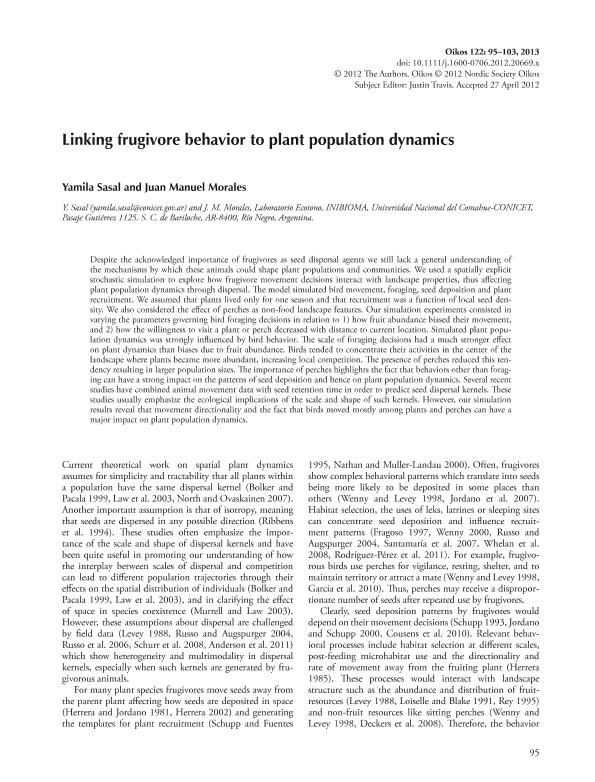Mostrar el registro sencillo del ítem
dc.contributor.author
Sasal, Yamila

dc.contributor.author
Morales, Juan Manuel

dc.date.available
2020-04-14T20:39:33Z
dc.date.issued
2013-01
dc.identifier.citation
Sasal, Yamila; Morales, Juan Manuel; Linking frugivore behavior to plant population dynamics; Wiley Blackwell Publishing, Inc; Oikos; 122; 1; 1-2013; 95-103
dc.identifier.issn
0030-1299
dc.identifier.uri
http://hdl.handle.net/11336/102561
dc.description.abstract
Despite the acknowledged importance of frugivores as seed dispersal agents we still lack a general understanding of the mechanisms by which these animals could shape plant populations and communities. We used a spatially explicit stochastic simulation to explore how frugivore movement decisions interact with landscape properties, thus affecting plant population dynamics through dispersal. The model simulated bird movement, foraging, seed deposition and plant recruitment. We assumed that plants lived only for one season and that recruitment was a function of local seed density. We also considered the effect of perches as non-food landscape features. Our simulation experiments consisted in varying the parameters governing bird foraging decisions in relation to 1) how fruit abundance biased their movement, and 2) how the willingness to visit a plant or perch decreased with distance to current location. Simulated plant population dynamics was strongly influenced by bird behavior. The scale of foraging decisions had a much stronger effect on plant dynamics than biases due to fruit abundance. Birds tended to concentrate their activities in the center of the landscape where plants became more abundant, increasing local competition. The presence of perches reduced this tendency resulting in larger population sizes. The importance of perches highlights the fact that behaviors other than foraging can have a strong impact on the patterns of seed deposition and hence on plant population dynamics. Several recent studies have combined animal movement data with seed retention time in order to predict seed dispersal kernels. These studies usually emphasize the ecological implications of the scale and shape of such kernels. However, our simulation results reveal that movement directionality and the fact that birds moved mostly among plants and perches can have a major impact on plant population dynamics.
dc.format
application/pdf
dc.language.iso
eng
dc.publisher
Wiley Blackwell Publishing, Inc

dc.rights
info:eu-repo/semantics/openAccess
dc.rights.uri
https://creativecommons.org/licenses/by-nc-sa/2.5/ar/
dc.subject
No tiene esta revista
dc.subject.classification
Ecología

dc.subject.classification
Ciencias Biológicas

dc.subject.classification
CIENCIAS NATURALES Y EXACTAS

dc.title
Linking frugivore behavior to plant population dynamics
dc.type
info:eu-repo/semantics/article
dc.type
info:ar-repo/semantics/artículo
dc.type
info:eu-repo/semantics/publishedVersion
dc.date.updated
2020-03-20T13:43:38Z
dc.journal.volume
122
dc.journal.number
1
dc.journal.pagination
95-103
dc.journal.pais
Reino Unido

dc.journal.ciudad
Londres
dc.description.fil
Fil: Sasal, Yamila. Consejo Nacional de Investigaciones Científicas y Técnicas. Centro Científico Tecnológico Conicet - Patagonia Norte. Instituto de Investigaciones en Biodiversidad y Medioambiente. Universidad Nacional del Comahue. Centro Regional Universidad Bariloche. Instituto de Investigaciones en Biodiversidad y Medioambiente; Argentina
dc.description.fil
Fil: Morales, Juan Manuel. Consejo Nacional de Investigaciones Científicas y Técnicas. Centro Científico Tecnológico Conicet - Patagonia Norte. Instituto de Investigaciones en Biodiversidad y Medioambiente. Universidad Nacional del Comahue. Centro Regional Universidad Bariloche. Instituto de Investigaciones en Biodiversidad y Medioambiente; Argentina
dc.journal.title
Oikos

dc.relation.alternativeid
info:eu-repo/semantics/altIdentifier/doi/http://dx.doi.org/10.1111/j.1600-0706.2012.20669.x
dc.relation.alternativeid
info:eu-repo/semantics/altIdentifier/url/https://onlinelibrary.wiley.com/doi/abs/10.1111/j.1600-0706.2012.20669.x
Archivos asociados
